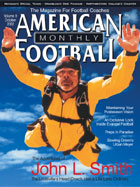AMERICAN FOOTBALL MONTHLY THE #1 RESOURCE FOR FOOTBALL COACHES
Article CategoriesAFM Magazine
|
Counter AttackNorthwestern College’s Counter Gameby: Bryan Johnson Offensive Coordinator, Northwestern College (St. Paul, MN) © More from this issue The past two seasons we have experienced tremendous success as a team and as an offense at Northwestern College. In 2001, we were one of only seven undefeated football teams in the country. Statistically, our best running play for each of the past five seasons has been the counter play. In 2000 and 2001 we averaged 6.9 and 7.1 yards a carry respectively using the counter. When we included all of the plays that came off our counter action, we accounted for 600 yards (14%) of our total offensive production for the year. There are many reasons why we run the counter. Our offensive linemen love to pull, and when it is well executed, it is fun for everyone to observe. Fro....The full article can only be seen by subscribers. Subscribe today!
|
|
|||||||
| HOME |
MAGAZINE |
SUBSCRIBE | ONLINE COLUMNISTS | COACHING VIDEOS |
Copyright 2025, AmericanFootballMonthly.com
All Rights Reserved





